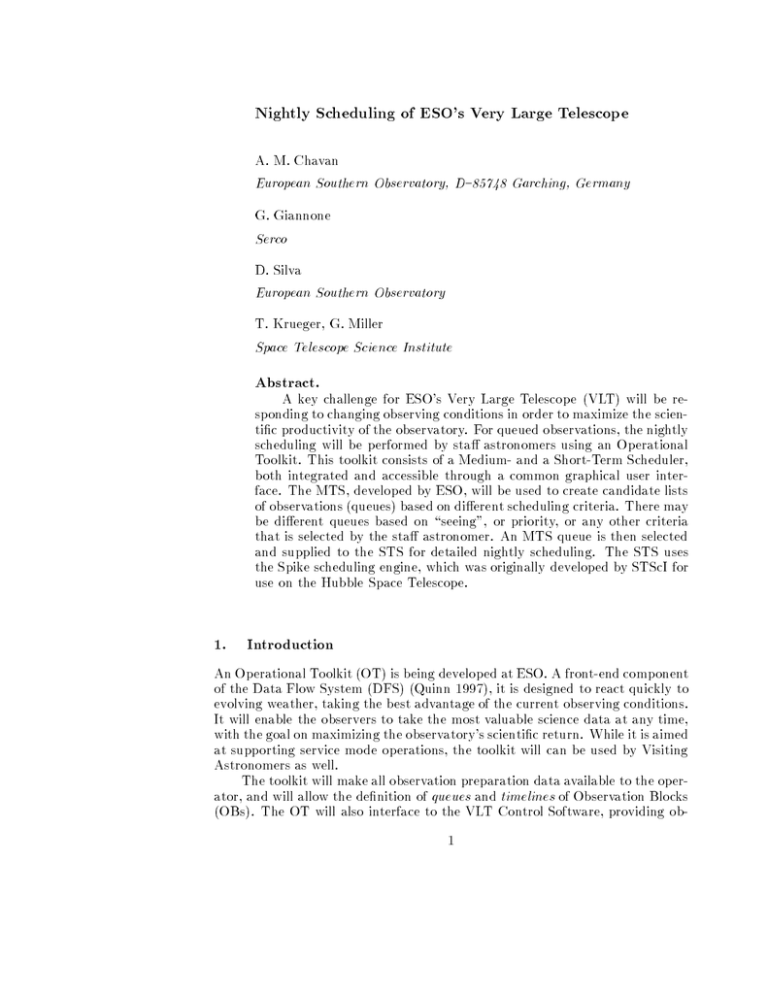A. M. Chavan European Southern Observatory, D{85748 Garching, Germany G. Giannone Serco
advertisement

Nightly Scheduling of ESO's Very Large Telescope
A. M. Chavan
European Southern Observatory, D{85748 Garching, Germany
G. Giannone
Serco
D. Silva
European Southern Observatory
T. Krueger, G. Miller
Space Telescope Science Institute
Abstract.
A key challenge for ESO's Very Large Telescope (VLT) will be responding to changing observing conditions in order to maximize the scientic productivity of the observatory. For queued observations, the nightly
scheduling will be performed by sta astronomers using an Operational
Toolkit. This toolkit consists of a Medium- and a Short-Term Scheduler,
both integrated and accessible through a common graphical user interface. The MTS, developed by ESO, will be used to create candidate lists
of observations (queues) based on dierent scheduling criteria. There may
be dierent queues based on \seeing", or priority, or any other criteria
that is selected by the sta astronomer. An MTS queue is then selected
and supplied to the STS for detailed nightly scheduling. The STS uses
the Spike scheduling engine, which was originally developed by STScI for
use on the Hubble Space Telescope.
1. Introduction
An Operational Toolkit (OT) is being developed at ESO. A front-end component
of the Data Flow System (DFS) (Quinn 1997), it is designed to react quickly to
evolving weather, taking the best advantage of the current observing conditions.
It will enable the observers to take the most valuable science data at any time,
with the goal on maximizing the observatory's scientic return. While it is aimed
at supporting service mode operations, the toolkit will can be used by Visiting
Astronomers as well.
The toolkit will make all observation preparation data available to the operator, and will allow the denition of queues and timelines of Observation Blocks
(OBs). The OT will also interface to the VLT Control Software, providing ob1
servation instructions and recording OB-related run-time events. Finally, the
toolkit will act as the interface to the OB repository for the whole Data Flow
System.
2. Operating the front end of the Data Flow System
Observation Blocks are modular objects, joining target information with the
description of the technical setup of the observation. OBs are created by investigators using another DFS front-end tool, the Phase II Proposal Preparation
System (P2PP; Chavan 1996), then checked into the ESO repository, where they
are veried for correctness by ESO.
The operations team then uses the Operational Toolkit to browse the repository and build queues, based on object visibility, expected observing conditions,
and user-dened scheduling constraints. A queue is a subset of the available OBs:
it usually covers one to a few nights of observation, and several queues can be
dened for the same night (e.g., based on dierent expectations on weather, or
equipment availability). An OB can belong to more than one queue at the time.
Later, as the observing night begins and progresses, the sta observer can
switch back and forth among the available queues, and build timelines (observing
plans) for each individual queue. Timelines are based on the current weather
conditions and OB priority, and can be built on several possible scheduling
strategies.
Events originating from the VLT Control Software or other DFS subsystems
| like a change in the current seeing conditions, the termination of an OB, an
instrument conguration change, or a failure while reducing the science frames
| are also received by the OT, and fed back into the scheduling process and
the OB repository.
3. Architecture of the Operational Toolkit
Users of the OT will see a single graphical user interface, and access OT functionalities through a unied set of commands and display widgets. However,
several independent components will cooperate behind the scenes to provide
such features, as shown in Fig. 1.
The OB repository will be implemented on top of a commercial DBMS,
running on dedicated servers in Garching (Germany), La Silla, and Paranal
(Chile). Database replication will be handled transparently to the users,
and will assure that the same up-to-date information is used for operations
throughout the system.
Repository browsing, queue management, and interaction with the VLT
Control Software and other DFS subsystems will be provided by the MediumTerm Scheduler (MTS). The browser will enable the OT user to select OBs
from the repository, based on target coordinates, object status, requested
instrument and instrumental conguration (like lters and grisms) and
scheduling constraints (see below). OBs can also be selected according
2
STS
OB
queues
Queue
timelines
GUI
MTS
Observing Programmes
Figure 1.
OB Repository
System architecture of the OT
to observation type (like imaging, spectroscopy, or calibration) and specic observing programmes or users. The amount of information to be
displayed in the browser per each OB can be customized by the operator.
OBs extracted from the repository will then be appended to queues (to
provide a certain degree of scheduling exibility, queues will normally oversubscribe the available time by a factor two). The user will then be able
to \zoom" in and out of the OBs, selectively displaying all the available
information in a hierarchical fashion. Queues can be ordered according to
a number of criteria, printed out, and sent to the STS for timeline computation. The currently selected OBs within a queue can be pulled by the
VLT Control Software for execution.
Finally, the MTS will have (read-only) access to the ESO Programme
(\Phase I") database as well.
Timelines will be computed by the Short-Term Scheduler (STS), a derivative of the scheduler used for the Hubble Space Telescope. The STS is
based on the Spike core (Johnston and Miller 1994), adapted for use in
ground-based observatories; it is being jointly developed by ESO and the
Space Telescope Science Institute in Baltimore, MD. Timeline computation will based on scheduling constraints and strategies.
OB scheduling is implicitly constrained by target visibility and availability
of congurable resources: an OB can not be scheduled if, e. g., it needs
a lter that is not currently mounted. OB authors will be able to further constrain execution by specifying exactly when and/or under which
conditions the observations can take place: the scheduler will honor timing constraints, sequencing (\chains") of OBs, weather constraints (like
seeing, sky transparency and IR emissivity) and moon-related constraints
(like fractional lunar illumination and moon angular distance).
3
Several scheduling strategies will be available, based on a combination of
factors like OB priority, weather evolution and a number of preference values: observations should be performed as close as possible to the zenith,
away from the moon, etc. Operators will be able to compare schedules
generated with dierent strategies, and chose the one optimizing the current queue. A number of dierent metrics and GUI tools will be available
to build and compare schedules, including a graphic display of the set of
scheduling constraints.
As we said, OB priority is an important scheduling parameter. ESO observing programmes are ranked by ESO's Observing Programmes Committee (OPC); when creating queues, the computation of an OB's priority starts from the OPC rank of the programme to which the OB belongs. However, priorities may change dynamically during the night, due
to weather evolution or programmes nearing completion, and the scheduling engine needs will keep track of them | as a result, the schedule will be
highly dynamical, and change several times during a night. This implies
important performance requirements for the Short-Term Scheduler.
Note that the STS is a support system, not an automatic scheduler: it can
be used to compute several timelines, but the ultimate responsibility over
which OB to execute, and when, rests with the VLT Data Flow operations
sta.
The usability of system as complex as the Operational Toolkit depends
largely on the friendliness of its user interface. We'll try to make sure that
(a) all OB and schedule information is readily available and easy to read,
(b) the user is always able to override the system's suggestions, and (c) all
of the tool's features are \one click away" (no double operations).
4. Perspective
A version of the MTS has been in operations at ESO's New Technology Telescope
(NTT) in La Silla since the beginning of 1997, including a large fraction of the
above listed features; feedback from early users proved invaluable in shaping
the tool's behavior and looks. The rst prototype of the STS was released in
November 1997 for in-house testing, with eld tests (at the NTT) foreseen for
the beginning of 1998. We plan to have a fully operational OT by the time
service observing at the VLT will start.
References
Chavan, A. M. and Albrecht, M. 1997, in ASP Conference Series, Vol. 125,
Astronomical Data Analysis and Software Systems VI, ed. G. Hunt & H.
E. Payne (San Francisco, ASP), 367.
Johnston, M. and Miller, G. 1994, in Intelligent Scheduling, ed. M. Zweben &
M. S. Fox (San Francisco, Morgan Kaufmann), 391.
Quinn, P. 1997, \The VLT Data Flow System: A Progress Report", in this
volume.
4







